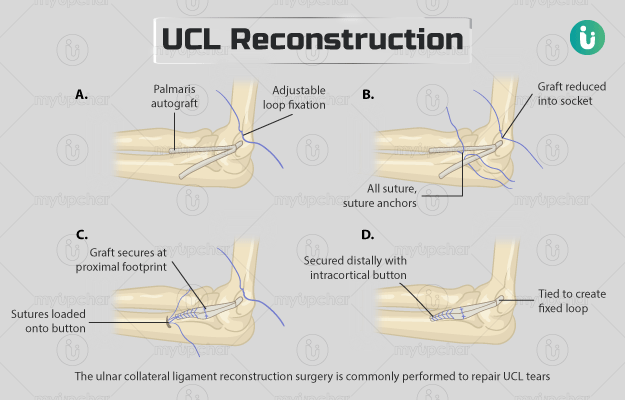Summary
Ulnar collateral ligament (UCL) reconstruction procedure is done to replace the damaged UCL of the elbow with a tendon taken from another part of the body. UCL is a piece of connective tissue connecting your upper and lower arm. An injury to the UCL can result in a tear, causing pain and restricted movement of the elbow joint. UCL tear usually occurs in individuals who have repetitive stress on their elbow, especially athletes in throwing games or overhead arm use.
The surgery is performed under general anaesthesia and lasts for about 60 to 90 minutes. You will be discharged on the same day. With a rehabilitation program after the surgery, most individuals can perform normal elbow movements. However, athletes require rigorous physical therapy after the surgery, and it may take them about nine months or longer to return to competitive sports.
- What is UCL reconstruction?
- Why is UCL reconstruction recommended?
- Who can and cannot get UCL reconstruction?
- What preparations are needed before UCL reconstruction?
- How is UCL reconstruction done?
- How to care for yourself after UCL reconstruction?
- What are the possible complications/risks of UCL reconstruction?
- When to follow up with your doctor after UCL reconstruction?
What is UCL reconstruction?
The ulnar collateral ligament (UCL) reconstruction surgery is commonly performed to repair UCL tears. It is also known as Tommy John surgery.
UCL is one of the ligaments located in your elbow that connects the humerus (the upper arm bone) to the ulna (a long bone in the forearm). Ligaments are bands of tissues that connect bones, especially in the joints, to control their movement. The UCL secures the elbow joint and thus helps stabilise and support the arm. However, an injury to the ligament may result in a tear that can cause pain in the elbow and affect your hand movements.
A UCL tear is a commonly occurring condition in athletes who participate in sports that require throwing or overhead arm use as these sports place repetitive stress on the ligament. It also occurs in individuals after elbow joint dislocation and elbow surgeries. The ligament tear can develop suddenly or gradually with repeated stress. A torn UCL either heals by stretching, or it does not heal at all. A UCL tear is divided into the following categories based on severity:
- First degree tear: The ligament is not expanded, but the individual experiences pain
- Second degree: The ligament has stretched, but the individual is still able to perform normal hand movements
- Third degree: The ligament tears and the individual is unable to perform any hand movements
In a UCL reconstruction procedure, the torn UCL is replaced with a tendon (tissues that connect bones to muscle fibres) taken from another part of the body. The tendon used to replace the damaged ligament is called a graft. The palmaris longus tendon in the forearm is the preferred graft; however, the gracilis tendon from the leg may also be used. The surgery helps resolve pain and restore the stability and motion of the affected elbow.
Why is UCL reconstruction recommended?
UCL reconstruction surgery is recommended in individuals with torn UCL. Candidates for the surgery usually include those who have:
- A lifestyle that puts the UCL ligament under repetitive stress
- Not shown any improvement with non-surgical treatments such as rest, application of ice, medications, and physical therapy
The following symptoms are generally observed in such individuals:
- A ‘pop’ sound from the elbow
- Pain in the elbow, especially after an extended period of heavy throwing
- Numbness or tingling sensation in the little and ring fingers
- Weak or clumsy hand grip
- Inability to accelerate your hand forward, especially while throwing
- Inability to straighten or stretch the elbow
- Swelling in the elbow after 24 hours of injury
Who can and cannot get UCL reconstruction?
A surgeon may not perform a UCL reconstruction if you:
- Have arthritis in the radiocapitellar or ulnotrochlear joint (in the elbow)
- Are unwilling or unable to undergo the rehabilitation program after surgery
What preparations are needed before UCL reconstruction?
Prior to the surgery, you may be asked to visit the hospital for a preoperative assessment. During the assessment, he/she may conduct a physical exam and ask you about your medical history. You may also be asked to undergo a few imaging tests like magnetic resonance imaging or X-rays to look at the ligament tear. Additionally, you will be given the following instructions to prepare for the surgery:
- Share a list of all the medicines that you take, including over-the-counter medications and herbs and let the doctor know if you are or may be pregnant, have any allergy or history of allergy to anaesthesia.
- Avoid smoking.
- Discontinue certain medicines one week prior to the scheduled date of the surgery, especially medications that thin your blood like aspirin, ibuprofen, and warfarin.
- Do not eat or drink after midnight before the surgery. This helps to prevent vomiting while you are under anaesthesia.
- Take a shower and remove make-up, nail polish, and body piercings before arriving at the hospital on the day of the surgery.
- Arrange for a family member, friend, or a responsible adult to drive you home after discharge from the hospital.
- Sign an approval or consent form if you agree to the procedure.
- Inform the doctor if you have a cold, flu, or cough during the days leading to the surgery. In such a scenario, your surgery may be postponed.
How is UCL reconstruction done?
After arriving at the hospital on the day of the surgery, the hospital staff will ask you to wear a hospital gown. In addition, they will start an intravenous (IV) line in your arm for the administration of essential fluids and medicines during the procedure. The surgery is performed under general anaesthesia (a sleep-inducing medicine) and involves the following:
- The surgeon will make three incisions (cuts) over the area from where the graft is to be taken. Once the graft is harvested, he/she will stitch close the cuts.
- Next, the surgeon will make a cut on the outside of your elbow and move aside the muscle fibres and other tissues over the damaged ligament.
- He/she will cut the torn ligament and remove it.
- Then, the surgeon will drill holes into your ulna and humerus bones and place the graft in place of the original torn ligament.
- Finally, he/she will thread the tendon to the holes made in your bones and secure it with screws or buttons.
The surgery will last for 60 to 90 minutes. You will regain consciousness after a few hours of surgery. After you are awake, you may experience some of the side effects of general anaesthesia such as sore throat, dry mouth, and restlessness for a few hours. You will be provided with a brace to secure your elbow and will be discharged on the same day if the surgeon feels that you are completely stable.
How to care for yourself after UCL reconstruction?
The surgeon will give you the following recommendations to take care of yourself after the surgery:
- You will have to wear a brace for a few weeks on your elbow. The brace will have a hinge to allow you to lock it at specific angles. This helps to reduce inflammation and protect the operated tissue.
- He/she will recommend you a rehabilitation program to allow you to completely regain the motion of your elbow.
- The rehabilitation program will start with physical therapy. The physical therapist will teach you a few exercises for your shoulders, biceps, wrist, and fingers to prevent the degeneration of tissues in your operated hand.
- You will be allowed to move your elbow gently after one to two weeks of the surgery.
- You will most likely be able to stretch your elbow and stop using the brace in about a month.
- About two to four months after surgery, most individuals who undergo regular physiotherapy are able to perform normal range of movements of the elbow joint.
Athletes need to undergo rigorous stretching and strengthening exercises. Most athletes require nine months or longer to return to their sport. The surgery has an 80% to 90% success rate. Overall, the procedure offers the following benefits:
- Complete or partial relief from pain
- Stabilisation of the elbow
- Helps regain full range of motion of the elbow joint
When to see the doctor?
Visit or call your healthcare provider immediately if you experience any of the following:
- Fever
- Chills
- Drainage from the incision site
- A feeling of soreness in the operated site
- Redness near the wound
What are the possible complications/risks of UCL reconstruction?
The potential complications associated with the surgery are:
- Infection
- Numbness or weakness (temporary/permanent)
- Damage to the graft
- Irritation of the ulnar nerve (a nerve near the ulna bone)
- Risks of general anaesthesia like lung infection, heart attack or confusion
When to follow up with your doctor after UCL reconstruction?
Before leaving the hospital after the surgery, the medical team will provide you with a schedule for follow-up appointments with the surgeon along with a rehabilitation program.
Disclaimer: The above information is provided purely from an educational point of view and is in no way a substitute for medical advice by a qualified doctor.
Surgery Cost In Your City
References
- Johns Hopkins Medicine [Internet]. The Johns Hopkins University, The Johns Hopkins Hospital, and Johns Hopkins Health System; Tommy John Surgery (Ulnar Collateral Ligament Reconstruction)
- UCONN Health [Internet]. University of Connecticut. Connecticut. US; Ulnar Collateral Ligament Tears
- Andrews JR, Jost PW, Cain EL. The ulnar collateral ligament procedure revisited: the procedure we use. Sports Health. 2012 Sep;4(5):438–441. PMID: 23016118.
- Erickson BJ, Harris JD, Chalmers PN, Bach Jr BR, Verma NN, Bush-Joseph CA, et al. Ulnar collateral ligament reconstruction: anatomy, indications, techniques, and outcomes. Sports Health. 2015 Nov-Dec;7(6):511–517. PMID: 26502444.
- National Health Service [Internet]. UK; Before surgery
- Boston Children's Hospital [internet]. Massachusetts. US; Tommy John Surgery In-Depth
- Hernandez A, Sherwood ER. Anesthesiology principles, pain management, and conscious sedation. In: Townsend CM Jr, Beauchamp RD, Evers BM, Mattox KL, eds. Sabiston Textbook of Surgery. 20th ed. Philadelphia, PA: Elsevier; 2017:chap 14
- Cohen NH. Perioperative management. In: Miller RD, ed. Miller's Anesthesia. 8th ed. Philadelphia, PA: Elsevier Saunders; 2015:chap 3
- Moucha CS. Surgical site infection prevention. In: Browner BD, Jupiter JB, Krettek C, Anderson PA, eds. Skeletal Trauma: Basic Science, Management, and Reconstruction. 5th ed. Philadelphia, PA: Elsevier Saunders; 2015:chap 22
- Webb TP. Surgical site infections. In: Cameron JL, Cameron AM, eds. Current Surgical Therapy. 12th ed. Philadelphia, PA: Elsevier; 2017:1334-1340















